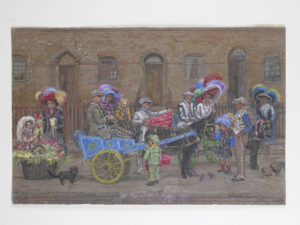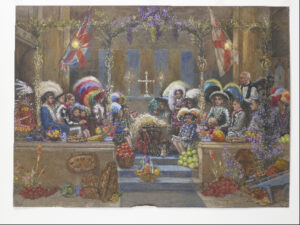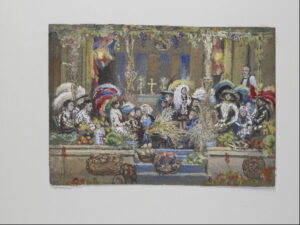The Pearly Festival
by Dr Juliette Wood (2008)
Click here to download the notes about the Canziani paintings, formerly on loan from The Folklore Society to The Museum of London, now held in The Folklore Society Archives and Collections, at University College London, Special Collections
In her autobiography Round About Three Palace Green, written when its author was fifty years of age, Estella Canziani referred to her extensive interests and experiences:-
‘One day I might be talking to a real crowned king or queen, and the next to a pearly king or to a queen crowned with feathers in an English slum.’
As the daughter of the artist Louisa Starr Canziani and a wealthy Italian engineer, Estella Canziani’s background in art and European culture was assured. She travelled extensively with her father after her mother’s death in 1909 and later on her own or with friends; yet London always remained her base.
Her links with the Arts and Craft movement were important not just for her art, but for her folklore research as well, since it made her aware of handicrafts as an expression of human endeavour and dignity.
In her travels through parts of Italy and Africa, she sketched and painted the clothing, ornaments, daily activities, house interiors and festivals of the regions she visited in order to document the traditional ways of life that she perceived to be losing ground to modern industry and mass communication. She also noted songs, proverbs and even folktales, such as the wonder tale, “Donkeyskin,” that she heard from a young Italian girl, and which appeared in an article in Folklore.
The most extensive collection of her paintings is now in the Birmingham Museum and Art Gallery, but the Pitt Rivers Museum, Oxford, and the Museum of London hold significant assemblages of artefacts and costumes collected by her in Italy and Morocco. Her lifestyle and dress also reflected the principles of the Arts and Crafts movement, and The London Museum has some of her personal clothing, with its emphasis on natural fabrics, ethnic ornamentation and comfortable modern design.
Canziani joined the Folklore Society in 1910 and became a member of its Council in 1911 after the publication of Costumes, Traditions and Songs of Savoy (London, 1911). She wrote articles and reviews for Folklore, and her obituary, written by her friend and sometime travelling companion, Evelyn Coote-Lake, was published in the Society’s journal in 1964.
Her interest in folklore began during her travels with her father in Savoy when she began to document the way of life she found there, and she eventually published three lavishly illustrated books on Savoy, Piedmont and the Abruzzi. Through her friends, Francis Burkitt, who was professor of theology at Cambridge and his wife, she met other Cambridge academics interested in folklore and anthropology, notably Sir James and Lady Frazer and Jane Harrison. Eventually a notice about the Folk-Lore Society in the newspaper caught her attention.
After the publication of her first book, Charlotte Burne proposed her for membership. ‘Having plunged into the world of folk-lorists and anthropologists’ she recalled, ‘I came to know and realize the tremendous value these sciences have for the world.’ Other Folklore Society friends included the Jewish scholar, Dr Moses Gaster and his wife, and, for a time, Canziani, a socially minded Quaker, taught art at one of the working girls’ clubs for Jewish girls. Another contact was the Society’s President, Professor Henry Balfour, who introduced her to the Pitt-Rivers Museum in Oxford to which she gave many objects. Many of these are from her travels in Morocco, a place she visited after the period covered by this book of reminiscences, which ends on the eve of the Second World War.
Her most famous painting, The Piper of Dreams, whose delicate fantasy provided a magical view of a pastoral utopia, was popular with soldiers during the First World War. However, many of her interests were far from romantic and centred on social reform and education. As the chapter on ‘A Pearly Festival’ in her autobiography makes clear, these social interests formed the background for the series of paintings she made of the Pearlies Harvest Festival which are now in the possession of the Folklore Society. The chapter begins with a description of the hardships of people in London after the First World War; the disruptions caused by the Great Strike, and of her work, mostly with children, under the aegis of the Quakers and through teaching art classes to working girls at their meetinghouse at Bethnal Green. Although she gives no specific details, this network of friends and fellow social workers led her to the Harvest Festival service at the Costers Church of St Mary Magdalene in the mid 1930s.
Canziani made two presentations to the literary and artistic group known as the Portfolio Society about her experiences collecting and recording this event. Both are included in Round About Three Palace Green and they provide invaluable background to the festival as it was celebrated at this time and to the identities of the people she painted. Members of the Portfolio Society contributed essays and poems and artworks. Originally these were circulated anonymously at meetings, and the portfolio in which they were passed round gave its name to the Society. Many notable literary figures such as Christina Rossetti were members. By the time Canziani was active, contributions were no longer anonymous and topics and speakers were generally known in advance.
The harvest festival was of no great antiquity. The vicar, Mr A Barker, had invited the local market traders to attend the service at St Mary Magdalene only about ten years before. Presumably, the clerical figure on the right of her picture of ‘The Costers Harvest Festival’ depicts this vicar. The traders, known as costermongers, had been involved in charity work and the wearing of elaborately decorated clothing since the middle of the 19th century. According to the vicar (and the Oxford English Dictionary), the traders, originally apple-sellers, were called costermongers because of the type of ‘costard’ apple they sold. The costume, with its elaborate pearl button patterns he thought had become popular about 1800, although other accounts put this somewhat later. He suggested that it developed from either Spanish or Regency period clothing styles, but here too accounts vary. The vicar also noted a tension between ‘genuine pearly traders’ and other charity workers who wore the characteristic decorated clothing but kept a percentage of their taking. Numbers of true pearlies, he said, were declining because covered markets were replacing open ones and new immigrant workers with different customs were taking over the costermongers’ traditional jobs.
Whatever the history, the festival which took place every second Sunday in October in St Mary Magdalene Church off the Old Kent Road was an established part of the local calendar. The service of lessons and hymns included delegates from other trade organizations, but the procession of costers, riding their donkey carts and dressed in finery, bringing gift baskets which were distributed to the poor after the service, was clearly the highpoint of the event.
Canziani mentions two “paintings” in her autobiography Round About Three Palace Green (1939), as having been given to the Folklore Society about 1937 and subsequently lent to the then London Museum (today the Museum of London). The “paintings” are in fact two large gouaches and several related sketches comprising a total of eight works and possibly a ninth, which is not among the present grouping.
One, “Birds of a feather” (1935) was exhibited at the Royal Academy and depicts costers in gala dress in the Old Kent Road with a donkey and cart.

The other, ‘Costers Harvest Festival in the Church of St Mary Magdalene, Old Kent Road’ (1936) appears to be the picture described by Canziani thus: ‘“the second picture was the interior of the church decorated for the Thanksgiving Harvest Festival and the Kings and Queens all seated in front of the altar. This picture was called “All Things Bright and Beautiful”.’

In addition to these, the Folklore Society owns five preliminary studies in colour for the finished gouaches and it is possible with the aid of Canziani’s notes for the Portfolio society to identify most of the figures. One sketch shows “Bert Matthews, Pearly King” who was later the subject of a ‘This is Your Life’ programme in the 1960s in recognition of his charity work.
The study entitled “Pearly Queen and Boy” is his wife Becky and ‘little Johnny,’ either a son or grandson of this well-known couple. Canziani sketched them in the yard behind their house, one filled with ferrets which this otherwise committed animal lover did not seem to like much.
The figures in another sketch entitled the “Hampstead Pearlies, donkey cart and girl” may in fact be Mr James Duckworth ‘the pearly King of the Old Kent Road’ with his wife and their young son and daughter. The costume worn by the man corresponds to Canziani’s description – ‘coat, collar, pockets, lapels, cuffs were each bordered with a triangular design in black velvet edged with pearl buttons and this design was also continued down the middle of each trouser leg’. In addition the donkey is without a covering, because this pearly king was proud of his harness and made of point of this to the artist.
A second study entitled “Hampstead Pearlies, flower sellers and man” may also be members of the Duckworth family, namely the daughter and son-in-law, who kept a flower stall near the King’s Arms, Peckham. The flower arrangement corresponds to the details recorded by Canziani – green foliage first, bunches of flowers laid flat with ‘their stalks to the middle’ and a few empty cans to give the impression that selling had been brisk. Canziani by the way bought the flowers used for this sketch, paid the sitters ten shillings each and offered them sweets.
All these figures appear in ‘Birds of a Feather’ plus two more. The woman on the extreme right may be one of Becky Matthews’ daughters, both of whom wear pearly coats with similar designs in photographs taken of the family in 1951. The second male figure seated in the coster’s cart may be a colourful character, nicknamed ‘Jack the Murderer’ whom Canziani spent six months tracking down, but the Portfolio Society notes do not indicate whether she actually sketched him in the end.
The final study, the “Pearlies Harvest Festival”, is described as a composition study for “Costers Harvest Festival” and shows the flowers, elaborate breads and various knots of ribbon used to decorate the Church during the festival. There may have been one further study, which is not part of Folklore Society collection at present. Canziani was much struck by a miniature coster cart drawn by a team of horses and accompanied by a miniature farmer in a smock placed in the centre of the altar during Harvest Festival. They had been made originally by a toy maker, but belonged to a local hatter who was quite willing to lend them out for charitable events. She painted them in the room about his shop on the Old Kent Road and they can be seen quite clearly in the finished gouache of the Harvest Festival.
The series of pictures and studies records not just a colourful London festival, but the working of an important artist and folklorist. Canziani, thanks to the essays she wrote for the Portfolio Society, also records other details such as the living conditions of the two pearly families she painted, the role of the vicar in introducing her and allowing her to use the churchyard, the fees for the sitters and the sweets (Cadbury’s peppermint creams and bulls eyes) that she offered to subjects who had to sit for long hours, and last but not least, the difficulties of painting outside in the face of uncertain English weather.
Selected Bibliography of Publications by Estella Canziani
“Abruzzese Folklore,” Folk-lore, vol. 39/3 (1928), pp. 209-47.
Costumes, Traditions and Songs of Savoy by Estella Canziani; illustrated with fifty reproductions of pictures by the author, and with many line drawings, London, Chatto & Windus, 1911.
“Courtship, Marriage and Folk Belief in Val d’Ossola,” Folk-lore, vol. 23/4 (1912), pp. 457-60.
“Sagra del Pesce, Camoglie,” Folk-lore, vol. 71/4 (1960), pp. 251-2.
“Savoy Traditions and Folk-Beliefs,” Folk-lore vol. 42/1 (1931), pp.60-67.
Piedmont, Estella Canziani and Eleanour Sinclair Rohde, London: Chatto & Windus, 1930.
“Piedmontese Proverbs in Dispraise of Woman, ” Folk-lore (1913).
“Piedmontese Folklore, 1-2,” Folk-lore vol. 24/2-3, 1913, pp. 213-8 and 362-4.
“Folklore Notes from Piedmont, III (Continued), Folk-lore vol. 25/3 (1914), pp.126-128.
Through the Apennines and the Lands of Abruzzi: Landscape and Peasant Life, described and drawn by Estella Canziani, Cambridge: W. Heffer & Sons, 1928.
Oxford’s College Gardens … With twenty-four illustrations in colour, and one black and white by Estella Canziani, and Eleanor Sinclair Rohde, London: Herbert Jenkins, 1932.
Round about Three Palace Green, by Estella Canziani, London: Methuen, 1939.
Oxford in Brush and Pen, compiled and illustrated by Estella Canziani, London, 1949.
